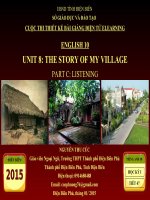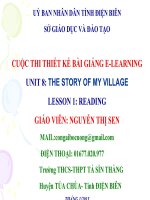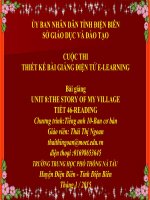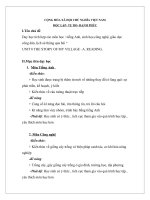Giáo án Tiếng Anh 10 Unit 8: The story of my village
Bạn đang xem bản rút gọn của tài liệu. Xem và tải ngay bản đầy đủ của tài liệu tại đây (200.17 KB, 50 trang )
Giáo án English 10
UNIT 8: THE STORY OF MY VILLAGE
The 43rd period
Date:
Grade 10
Theme: The story of my village
Unit 8
Reading
Time: 45 minutes
I. Objectives:
1. Educational aim: Students should understand all the changes in the country life
nowadays
2. Knowledge:
- General knowledge: By the end of this lesson, students will be able to:
- better their reading skill through vocabulary Matching and
Table completion exercise
- enlarge vocabulary about country life
- Language
- New words: Words related to country life
3. Skill : Reading for gist and for specific information about country life
II. Method: Intergrated mainly communicative
III. Teaching aids: Textbook, pictures about country life
IV. Procedure:
Teacher’s activities
Students’ activities
Warm-up :(2 minutes)
- Greeting
- Answer freely
- Rasing some questions:
+ How are you today?
+ Do you like living in the city or - city/ country
living in the country?
+ Why do you like that?
- Say: “Well, today we’ll come to Unit
8: Reading to visit the life of the
village and discover some interesting
things in the country”
Pre-reading: (10 minutes)
- Ask students some questions:
- because of fresh air etc.
- Listen to the teacher
Notes
1. What can you see in the picture?
2. Who are they?
3. What are they using?
1. This is a picture of
village.
2. The farmers are.
- Open your book!
3. They are planting/
ploughing etc.
* Vocabulary:
- Ask students to read through the
passage and find some new words
+ straw (n): dry cut stalks of various
- Read individually
cereals
+ mud (n): wet, soft soil
+ brick houses: houses made of bricks
- Listen to the teacher
and write down
+ thanks to (prep): owing to, because
of
+ farming methods (n): ph¬ng ph¸p
canh t¸c
- Ask students read all the new words
in chorus
- Call some students to read again
- Read in chorus
- Check pronunciation
- Read individually
* Ask students to work in pairs and
discuss the questions in the book
- Work in pairs and give
- Call on some students to give their answers
answers
- Listen and correct
1.
The
farmers
are
harvesting crop.
2. They are working very
hard.
3. It’s a good/ bumper
crop.
4.
Good
farming
methods, good varieties,
modern technology used,
people work hard
While-reading: (22 minutes)
You’re going to read a passage about
life changes in the country. You - Listen to the teacher
should read it and do the tasks.
* Task 1: Vocabulary Matching
- Ask students to read all the words in
A, then read the passage to underline
those words which all appear in the
- Read the passage and
passage
underline new words
- Encourage students to guess the
meanings of the words in the context
-
Try
to
guess
the
- Have students compare their answers meanings of the words
with a friend
- Work in pairs
- Call on some students to explain their
answers in front of the class
- Make necessary corrections
- Listen to their friends
answers
- Give correct answers:
1.b - 2.d - 3.a - 4.e - 5.c
- Listen to the teacher
- Ask students to translate those word and correct
phrases into Vietnamese
- Do translating
- Check their answers by giving
Vietnamese equivalents if necessary
1. kiếm tằn tiện đủ sống
2. thiếu thốn nhiều thứ
3. cải thiện cuộc sống
4. vụ mùa bội thu
5. cây trồng để bán và thu lợi nhuận
* Task 2:
- Listen to the teacher
and
take
necessary
notes
if
- Let students read the table carefully
before doing the task
- Read the task
- Ask students to scan the passage to
get specific information and find out
the sentences which related to the - Work individually
words in the first column of the table
- Go round the class and provide help
when necessary
- Let students compare their answers
with a friend
- Check the answers in front of the
class as a whole
- Work in pairs
- Give correct answers
* Task 3: Answering questions
- Ask students to read the passage
again and then do the task 3
- Tell students to underline the
information that support the answers
- Have students compare their answers
with a friend
- Call on some students to read aloud
their answers in front of the class and
- Read independently
give explaination
- Work in pairs
- Give feedback and correct answers
1. It was poor and simple.
2. Because they hope that… (the last
sentence-1st paragraph)
3. They introduced… (2nd sentence-2nd
paragraph)
- Listen to the teacher
and correct the answers
4. He said their lives… (3rd paragraph)
5. He told … (4th paragraph)
Post- reading: (10 minutes)
- Ask students to work in groups and
discuss the question: How can people
with an education help make the life of
their community better?
- Tell students to look back to the
passage to get the ideas for the
questions
- Work in groups and
answer the question
- Go around and help students if
necessary
- Listen and check
- Give suggested answers:
+ Introduce new farming methods
+ Grow cash crops for export
+ Help local people apply modern - One student present the
technolody in farming
+ Help community especially young
answers in front of the
class
people access to ways of entertainment
+ Raise people’s awareness about
food safety and environmetal hygiene
- Listen to the teacher
and write down
Homework: (1 minutes)
- Ask students to write about the - Copy down on the
changes in their village nowadays (100 notebooks
words) at home
The 44th period
Date:
Grade 10
Theme: The story of my village
Unit 8
Speaking
Time: 45 minutes
I. Objectives:
1. Educational aim: Students should understand how to talk about their plans and
results
2. Knowledge:
- General knowledge: By the end of this lesson, students will be able to talk about
plans to improve life of a village and their possible results
- Language
- New words: Words related to verbs of improving life in a village
3. Skill : Speaking about their own plans to improve life of a village fluently
II. Method: Intergrated mainly communicative
II. Teaching aids: Textbook, black board
III. Procedure:
Teacher’s activities
Students’ activities
Pre-speaking: (10 minutes)
Brainstorming
- Tell students to close the book
- Ask students to work in groups
- Work in groups
- Ask students to make the list of ideas
that can be carried out to improve the
village life
- Ask the groups to raise their ideas
- Take notes on the board
- Say: “Ok, your ideas are very good.
You’re very honor to improve your - Listen to the teacher
village. And in order to help you more,
we’ll go to part Speaking, Task 1 and
find how the villagers of Ha Xuyen
improve their lives in the village”
While-speaking: (25 minutes)
* Task 1:
- Ask students to open the book and
look at the situation in Task 1 and read
the content first
Notes
- Ask students to do Matching
- Work individually
- Expalin some possible new words:
+ resurface (v) = renew
+ canal (n): man-made waterway for - Write down
irrigation
+ mudly (adj): full of mud
- Call on some students to read aloud
their answers in front of the class and
give their explaination for their answers
- Check the answers again in front of
the class as a whole
- Listen to their friends’
- Give correct answers:
answers
1.b - 2.g - 3.d - 4.e - 5.f - 6.c
* Task 2:
- Correct the answers
- Let students work in groups of three:
read and practise the conversation in
task 2
- Go around and help students if
needed
- Call on some groups to practise the
conversation in front of the class
- Work in groups
- Check their pronunciation
- Give the structure of Conditional - Practise speaking the
sentence type 1
If clause
conversation
,
If + S + do
main clause
, S + will/ can… +
do
- Ask students to give comments on
the structure
- Conditional Sentence
Type
1
is
express
something can happen in
- Ask students to make more sentences
with the above structure
the present
- S1: If he studies hard,
he’ll not fail the exam.
Post- speaking: (10 minutes)
- S2: …..
* Task 3:
- Keep students to work in groups and
continue the conversation, using the
ideas in the table in Task 1 or their
own
ideas
by
using
Conditional
Sentence Type 1
- Go around the class and provide help
when necessary
- Call on some groups to act out the
- Work in groups
conversation in front of the class
-
Give
comments
and necessary
corrections
- Ask the teacher if
necessary
- Some groups present
their
conversations
in
front of the class
Homework: (2 minutes)
- Write a conversation about your
village
- Listen to the teacher
and write down
The 45th period
Date:
Grade 10
Theme: The story of my village
Unit 8
Listening
Time: 45 minutes
I. Objectives:
1. Educational aim: Students can listen for information about the changes of a
small town in England
2. Knowledge:
- General knowledge: By the end of this lesson, students will be able to:
- compare the past and the present of a town
- improve listening skill through T/F and Gap-filling
exercises
- Language
- New words: Words related to verbs of improving life in a village
3. Skill : Listening to a specific information
II. Method: Intergrated mainly communicative
II. Teaching aids: Textbook, black board, cassette player…
III. Procedure:
Teacher’s activities
Students’ activities
Pre-listening: (14 minutes)
-Ask students to look at two pictures - Look at the pictures
of the same town in the book and find and do the task under the
as many the differences as possible teacher’s instruction
between them
- Ask students to work in pairs
- Call on some students to share their
findings in front of the class
- Work in pairs
- Some students present
their findings aloud
Ex: car, small road, buffalos etc.
- Review the structure of “used to” : to
express a past habit
- Retell the structure and
how to use it
Form:
+ S + used to + V + O
- S + didn’t use to + V + O
? Did + S + use to + V + O?
- Give more structures related to “used
to”
- Listen to the teacher
and write down on the
notebooks
Notes
+ To be/to get used to + V-ing
(to express a present habit)
- Give examples and to analyse the - Listen to the teacher
difference between two structures
Ex:
1. My father used to smoke.
2. My father is/gets used to smoking.
(1): My father smoked in the past, and
now he doesn’t smoke
(2): My father is smoking now.
- Ask students to make more sentences
with the above structures
- Correct the mistakes
A: I used to cry at
midnight when I was a
child.
B: I used to play with a
doll when I was 5.
C: I get used to going to
bed late.
………………………
While-listening: (20 minutes)
You will hear someone talk about the
changes in his hometown. Listen to the
talk and do the tasks that follow.
* Task 1: True or False
- Ask students to guess if the
statements are T or F before listening
- Do guessing
- Let students give answers in chorus
- Say: “Ok, now, listen to the tape and
check your answers according to the
- Answer in chorus: 1. F/
2. T ….
talk”
- Ask students to do the task
individually first
- Work independently
- Play the tape several times if
necessary
- Have students compare their answers
with a friend and correct the false ones
- Call on some students to read their
- Work in pairs
answers aloud in front of the class
- Feedback and give correct answers
1. F (It’s on the south coast of
England)
2. F (It’s used to be a small quiet
town)
- Listen to their friends
and find out mistakes
- Correct the answers
3. T
4. F (A lot of trees have been cut down
for wider streets)
5. F (Some people don’t like the
changes, they miss the quiet and
peaceful life of the old town)
* Task 2: Gap-filling
- Tell students to read a part of the talk
carefully and have a guess of the
missing words before listening
-
Read
the
talk
- Ask students to listen to the tape individuaaly
again and fill the gaps with the words
they hear
- Play the tape more than once if
necessary
- Listen to the tape again
and do the task
- Remind students to write the exact
and grammatically correct words
- Call on some students to explain their
answers in front of the class
- Correct the answers by playing the
tape sentence by sentence
- Correct the answers:
1.house-2.hotel3.widened-4.cut-5.car
Post- listening: (10 minutes)
6.shop-7.department-
- Ask students to work in groups to
8.expensive
discuss the changes in your own
hometown or home village
- Notice students to use the present
perfect and “used to” to show the
changes: there is/are used to; there
- Work in groups and do
discussing
used to be…
- Go around the class to provide help
- Call some students to give their short
talks in front of the class
-
Have
comments
on
students’
performance and correct the mistakes
Homework: (1 minutes)
- Write 10 sentences about what you
used to do in the past and what you are
used to doing in the present at home
- Write down
The 46th period
Date:
Grade 10
Theme: The story of my village
Unit 8
writing
Time: 45 minutes
I. Objectives:
1. Educational aim: Students can write and give direction to a certain place to
somebody
2. Knowledge:
- General knowledge: By the end of this lesson, students will be able to write a
letter giving directions to a certain place
- Language
- New words: Words related to direction verb-phrases
3. Skill : Writing a letter giving directions
II. Method: Intergrated mainly communicative
II. Teaching aids: Textbook, photocopy of the A0-sized map
III. Procedure:
Teacher’s activities
Students’ activities
Notes
Warm-up: (4 minutes)
- Ask students some questions:
- Answer the questions
1. Where do you live?
1. I live on QT street.
2. What’s your address?
2. Number 73
3. Class! Do you know the place 3. Sorry, I can’t/ I don’t
where she/ he lives? Could you show know ect.
me how to get there?
- Say: “Ok, today we’ll learn how to
give directions to a certain place. Open
your book! P.87”
Pre-writing: (5 minutes)
- Call on 2 students to go the board
and follow teacher’s directions (using - 2 students do following
direction sentences)
the teacher’s directions
Come on! turn right, go ahead, go - The whole class join
past Linh, turn left. Well, sit down, the game
please!
- Ask students to realize/show how to
show the way to a place
- Say: “You use some
special words, such as:
- Say: “Is it interesting? Now, look at
your book and read the letter individually, turn right ect”
then underline direction phrases”
While-writing: (20 minutes)
* Task 2:
- Explain some new words by using
signals and wrote on the board:
+ come (get) out
+ turn right/ left
+ keep walking
+ go over
- Read the letter in the
book and underline
- Rasing some questions
if necessary
+ walk past
+ take the first/ second
- Give more words:
+ go ahead = keep straight
+ go along
+ go down/ up ect.
- Listen to the teacher
and take notes quickly
- Let students read aloud these words
in chorus
- Call some students to read new - Read in chorus
words to check pronunciation
* Ask students stop reading
- Ask students to find Ann’s house on
the map in the book in pairs following
the intruction in the letter
- Check the answer in chorus
- Show Ann’s house
* Task 1:
- Tell students to read the letter again
quickly
- Hang the A0-sized map on the board
- Ask students to look at the map and
find Ann’s house
- Call one students to go to the board - Look at the map and do
and show the way to Ann’s house on the task
the large map in front of the class
- Confirm the direction again
- One student to show
the way to Ann’s house
in front of the class
Post- writing: (15 minutes)
Your house is A on the map. Write a
letter to Jim, telling him the way to
your house from Roston Railway
Station
- Listen to the teacher
- Ask students to write the letter
independently
- Remind students to use directionphrases
- Do the task individually
- Go around to provide help if
necessary
- Have students compare their writing
with a friend
- Pick up some writings and correct in - Work in pairs
front of the class
- Correct mistakes
Homework: (1 minutes)
- Write a letter to your friend to show
the way to Nguyen Trai High School
- Write down
The 47th period
Date:
Grade 10
Theme: The story of my village
Unit 8
language focus
Time: 45 minutes
I. Objectives:
1. Educational aim: Students can pronounce 2 sounds / au / - / ∂u / correctly and
understand how to use reported speech and conditional
sentence type 1
2. Knowledge:
- General knowledge: By the end of this lesson, students will be able to:
- pronounce the sounds / au / - / ∂u / clearly and correctly
- transform direct speeck into reported speech following
correct rules
- say the difference between when and if in conditional
sentence type 1 and do related exercises
- Language









